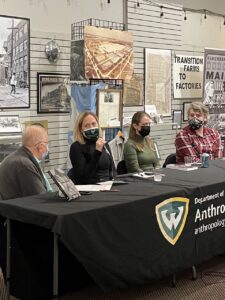‘Detroit Remains’ takes a dive into area’s archeological sites

Wayne State University professor Krysta Ryzewski (second from left) recently held a launch of her new book “Detroit Remains” at the Hamtramck Historical Museum.
By Greg Kowalski
Think of archeology, and you probably won’t think of hot jazz and ballroom dancing.
But in Detroit, a city just over 300 years old, such modern concepts — and more — do serve as fascinating archeological subjects. Wayne State University professor Krysta Ryzewski shows that, in her new book “Detroit Remains,” which explores six such modern archeological sites she and her students have studied.
The sites covered include the Blue Bird Inn, Grande Ballroom, Little Harry’s Speakeasy, Gordon Park, the Ransom Gillis House and the log cabin found — then lost — just north of Hamtramck.
Many folks remember the Grande Ballroom, and probably have seen the Ransom Gillis House in Brush Park, which was remarkably restored. But almost forgotten is Gordon Park, the exact site where the 1967 Detroit Riot began.
All these sites share a connection in that they are in Detroit and have relatively recent histories, at least on an archeological scale. But they are fascinating sites worthy of study.
Ryzewski explained their importance, and the value of contemporary historical sites at a special launching of “Detroit Remains” held recently at the Hamtramck Historical Museum.
About 70 persons (all properly masked) attended the event, which included a panel discussion involving Ryzewski; students Athena Zissis and Lorin Brace, who worked on archeological digs with Ryzewski; and panel moderator Greg Kowalski, executive director of the museum.
“I was on a mission when I wrote ‘Detroit Remains,’” Ryzewski later said, “not only to introduce readers to local archeology sites, and to reveal hidden histories, but to emphasize that the city does not lie in ruins.
“Tangible traces of the lives of everyday Detroiters and Hamtramckans survive — below and above ground, and the stories these objects reveal about places and people connect with the many communities in the past who contributed to the cities we know and love today.
“An archeological approach to the six sites in ‘Detroit Remains’ allowed my students, community partners and I to unearth these stories, and to mobilize them in wider conversations about social justice, education, historic preservation and city planning.”
Ryzewski is quite familiar with Hamtramck. She led two archeological digs in the city in recent years at the site of the former Village Hall at Grayling and Jos. Campau streets. She also led the effort to preserve the log cabin that had been discovered on Halleck Street just north of Hamtramck.
She worked with the Hamtramck Historical Museum to move the cabin to Hamtramck, but it was demolished suddenly by the City of Detroit Land Bank. She lays out the whole story in a chapter in “Detroit Remains.”
“Detroit Remains” is published by the University of Alabama Press. A limited number of copies are on sale at the museum at $39.95. Copies also can be ordered by calling (800) 621-2736, or through the University of Alabama website, uapress.ua.edu., or at the Hamtramck Historical Museum, 9525 Jos. Campau.
The museum is open 11 a.m. to 3 p.m. on Fridays and Sundays, and 11 a.m. to 4 p.m. Saturdays, and by appointment. Call (313) 690-9390.
(Greg Kowalski is the executive director of the Hamtramck Historical Museum.)
Posted Feb. 4, 2022

